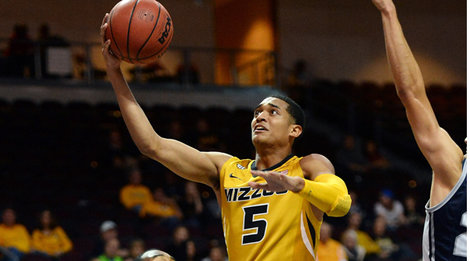Tulsa Transfers Jordan Clarkson and Eric McClellan Thriving in the SEC
Posted by Greg Mitchell (@gregpmitchell) on December 16th, 2013In an alternate universe, Tulsa got a big win over Oklahoma last Saturday, with Danny Manning making an intrastate statement on the strength of his starting backcourt. The Sooners couldn’t match up with Jordan Clarkson and Eric McClellan, both of whom got to the rim with ease. But Tulsa didn’t beat Oklahoma on Saturday night, and Clarkson and McClellan haven’t suited up for the Golden Hurricane in nearly two years. Instead, Tulsa’s 2011-12 starting backcourt bolted after a coaching change and have emerged as two of the better scorers in the SEC this season.
Tulsa transfers at a glance
- Jordan Clarkson (Missouri): 6’5″, 193 pounds, 32.4 MPG, 20.2 PPG, 3.8 APG, 60.1% TS.
- Eric McClellan (Vanderbilt): 6’4″,’ 188 pounds, 33.0 MPG, 16.5 PPG, 3.6 APG, 50.1% TS.
The link between Clarkson and McClellan is closer than playing at the same school and transferring to the same conference. McClellan was lightly-recruited out of high school, receiving only four scholarship offers and none from a major conference. But it was Clarkson who was the reason Tulsa won the four-team derby for McClellan that also included Northeastern, Fresno State, and Wichita State:
McClellan arrived at Tulsa after following the path of a high school hoops hero: Jordan Clarkson. Clarkson was a household name in Texas; he was named San Antonio High School Player of the Year his senior year and led Wagner High School to a 105-14 record in three seasons as a starter. McClellan said, “I’m like, if this program can get a caliber player like Jordan, I want to go there and learn from him, too. That’s the main reason why I went there.”
When Doug Wojcik’s staff was fired after the 2011-12 season, McClellan followed assistant David Cason to Vanderbilt. But that wasn’t his plan at first, according to InsideVandy.com; rather, McClellan thought he would stay at Tulsa until he was out of eligibility. It was only after he talked with Clarkson about his impending move to Missouri that McClellan began to think about going elsewhere too. Clarkson’s decision was likewise influenced by another player: Former Missouri guard and lightning rod for criticism, Phil Pressey, grew up playing basketball with him in San Antonio, and it was he who encouraged Clarkson to check out Missouri. He spent his transfer year working out with another key piece to his recruitment, assistant Tim Fuller, whom he credits for the clear growth in his game:
The private sessions — before practices, after practices, before games, after games — were strenuous, but natural. Fuller was integral in recruiting Clarkson. He got him on the phone. He got him to campus. “He was my guy,” Clarkson said. “He was almost like one of my uncles, you know?”
Clarkson finds himself in an ideal situation this season, regardless of whether he fully realized it when he chose Missouri. He has been forced by necessity to play out of position at point guard because of Pressey’s early departure, allowing him to dominate the ball and shoot at a high volume. His strength of getting to and finishing at the rim is complemented by Jabari Brown and Earnest Ross’ shooting, and the Tigers no longer have an offensive-minded big man that needs a steady diet of low post touches. The offense is essentially a blank canvas for Clarkson’s talents, and he’s made the most of it by leading the SEC in scoring and, more importantly, leading Missouri to several big non-conference wins.

McClellan has stepped into the void in Vanderbilt’s backcourt and is leading the team in scoring (Credit: bigstory.ap.com).
McClellan has ended up in a similar situation. Vanderbilt lost four players from its potential backcourt rotation for various reasons during the offseason. Kedren Johnson was dismissed from school; Kevin Bright returned to his native Germany to play professionally; Shelden Jeter and A.J. Astroth both transferred. This left the Commodores very thin at the guard position, but McClellan has seized the opportunity to play immediately. In 33 minutes per game, he has the third highest usage rate in the SEC at 30 percent, and he has attempted the ninth most fields goals in the conference. His efficiency needs to improve, as he turns it over too much and is only shooting 43 percent overall, but McClellan, like Clarkson, has shown he can be dynamic in getting to and finishing at the rim.
McClellan is the type of player who can still put up points even when his shots aren’t falling. Vanderbilt’s game against Texas two weeks ago is a good illustration of this. He was woeful from three that night, going 1-of-7 from distance. Yet he still managed to score 22 points and lead the Commodores’ second half comeback by getting to the free throw line 15 times (making 11). His assist numbers have also been good this year. Transfers are often juniors, but McClellan is only a sophomore and Kevin Stallings must be excited about what he can do with three seasons of development.
Back in Tulsa, the Golden Hurricane has only three wins this season and are scoring 74.1 points per game. Danny Manning’s team has played a difficult schedule, but it’s not a leap to imagine both of those numbers quite a bit higher if Clarkson and McClellan has stayed on campus. Instead, the pair has become two of the better scorers in the SEC and each probably has the January 16 match-up between Missouri and Vanderbilt circled on their calendars.












































My how times have changed- they both might have been well served with practicing a little patience and sticking with Manning